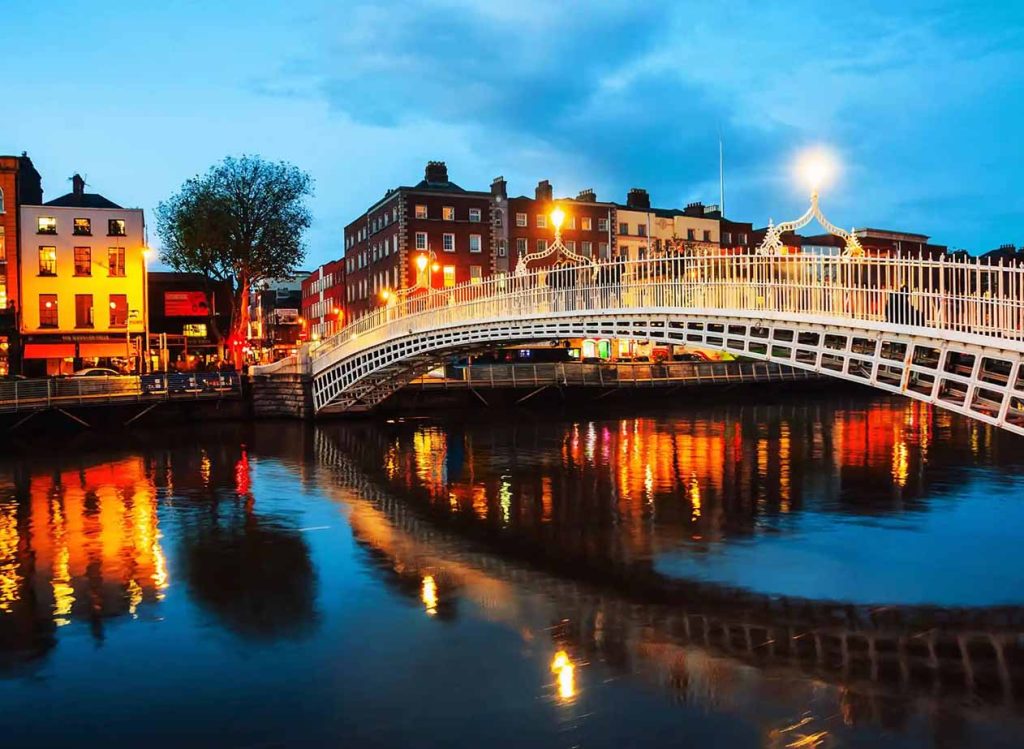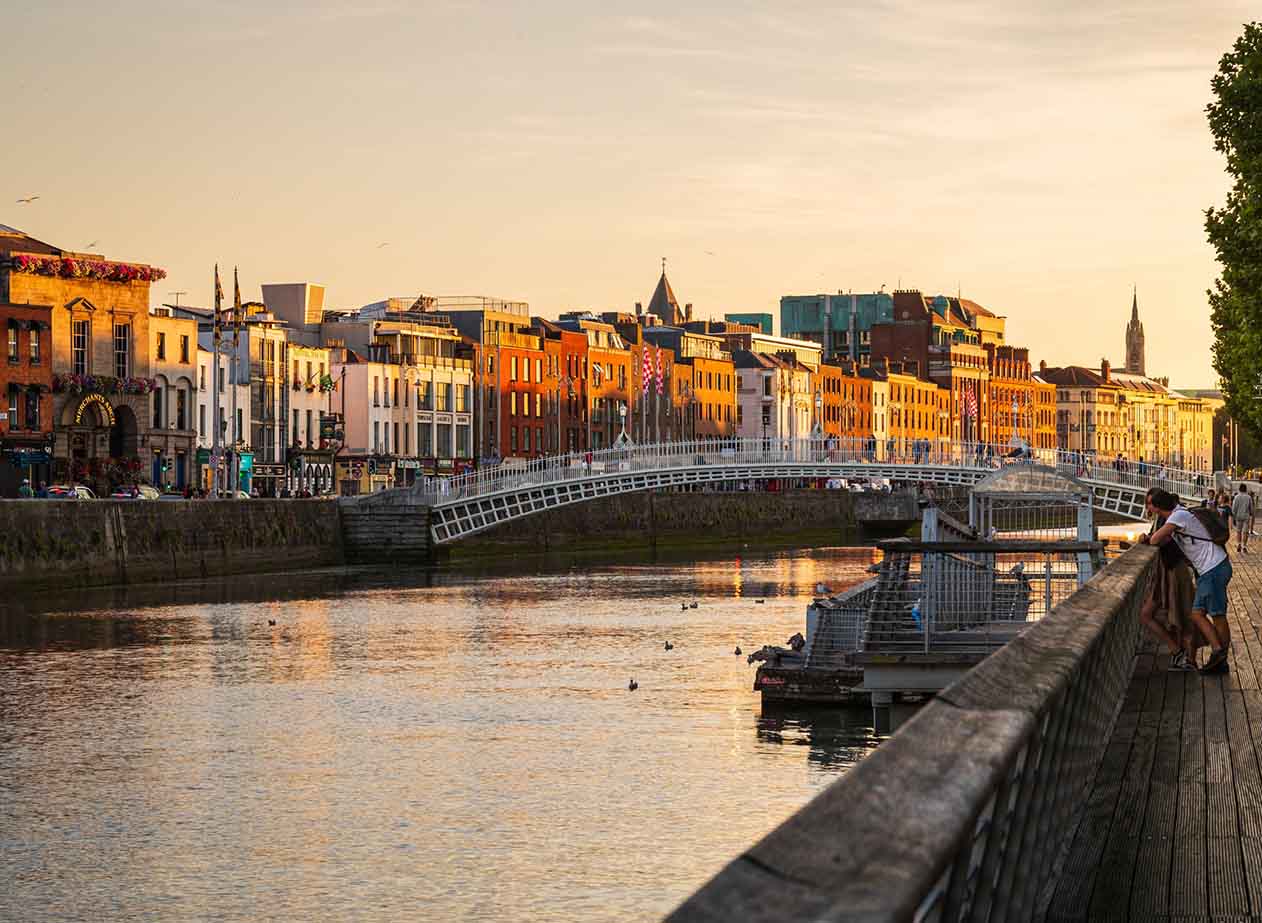Dublin, the historic capital of Ireland, attracts tourists from all over the world with its rich cultural heritage, enthusiastic citizens and charming street scenes. However, when it comes to the weather in Dublin, many tourists are often confused and doubtful – do you need to prepare rain gear for travel? How to choose the right clothes to cope with the changeable local climate?
1. Overview of Dublin’s climate: mild and humid marine climate
Dublin belongs to a typical temperate marine climate. The main characteristics of this climate type are small temperature differences and evenly distributed rainfall. Due to its proximity to the Atlantic Ocean, the sea breeze regulates the temperature, making the winter milder and the summer not too hot.
1.1 Temperature changes
Winter (December to February): The average temperature is about 3 to 8 degrees Celsius, and frost or snowfall rarely occurs. The feeling of coldness comes more from damp and cold air rather than low temperature.
Spring (March to May): The temperature gradually rises, averaging 5 to 12 degrees Celsius, and the weather changes frequently, with more alternations of sunny and rainy days.
Summer (June to August): The temperature is relatively comfortable, averaging about 15 to 20 degrees Celsius, rarely exceeding 25 degrees, and is the peak tourist season.
Autumn (September to November): The temperature slowly drops, the weather gradually turns cooler, and the rainfall gradually increases.
1.2 Rainfall characteristics
The rainfall distribution in Dublin is very even, and there is rainfall weather almost all year round, especially in spring and autumn, when the frequency of rain is high, but the rainfall intensity is generally not large, usually manifested as drizzle or showers.
2. Analysis of rain gear needs in Dublin
Whether to carry an umbrella during travel preparation is a concern for most tourists. Combining Dublin’s climate and daily rainfall conditions, it is particularly important to make scientific rain gear preparations.
2.1 Practicality of Dublin Umbrellas
Although Dublin has frequent rainfall, it is mostly short-term drizzle or showers, and the wind is relatively mild. Using an umbrella can effectively block the drizzle and keep you dry.
Lightweight umbrella: It is recommended to choose a small, easy-to-carry folding umbrella, which is convenient to carry in a backpack or bag, so that you can respond to sudden light rain at any time.
Wind-resistant design: Although the wind in Dublin is not extreme, the wind direction is sometimes uncertain. Umbrellas with windproof structures can improve the comfort and durability of use.
2.2 Advantages of raincoats and waterproof jackets
Compared to umbrellas, waterproof jackets (especially lightweight ones with hoods) are more practical in some cases:
When the wind is strong, umbrellas are easily blown over, and raincoats can better protect the whole body.
Hands are free during activities, suitable for outdoor activities such as hiking or cycling.
Modern waterproof fabrics are light and breathable, comfortable to wear and easy to carry.
Umbrellas and raincoats should be prepared according to personal needs and the type of activity.
3. Specific weather characteristics and rain gear recommendations for each season
3.1 Winter (December to February)
Dublin has mild temperatures in winter, a higher probability of rainfall, and many rainy days.
It is recommended to bring a warm and waterproof jacket, preferably with a hood, which can keep out both cold and rain.
Umbrellas can be used as a backup to facilitate short-distance movement within the city.
Due to the temperature difference between morning and evening, layered clothing (such as sweaters + jackets) is more appropriate.
Waterproof and wear-resistant winter shoes should be selected to prevent long-term wet environment from causing foot discomfort.

3.2 Spring (March to May)
Spring is a season of changeable weather, with frequent alternations between sunny and rainy.
Light umbrellas and waterproof windbreakers are essential to deal with showers.
As the temperature gradually rises, it is recommended to wear light and warm layers, and add a sweater or fleece jacket in the morning and evening.
Waterproof sports shoes or casual shoes are preferred, which are both comfortable and practical.
3.3 Summer (June to August)
Summer is the driest and warmest season in Dublin, but rain may still strike.
A small and portable folding umbrella is a good choice to deal with occasional light rain.
Wearing should be mainly breathable and light short-sleeved and thin jackets, and a light waterproof jacket should be prepared.
The sun may be strong on sunny days, so it is recommended to bring sunscreen.
Choose lightweight and breathable sports shoes or casual shoes.
3.4 Autumn (September to November)
The weather gradually turns cooler in autumn, rainfall increases, and wind sometimes increases.
It is recommended to wear a thick waterproof jacket to keep out the cold and rain.
Umbrellas are still suitable, but it is recommended to choose styles with better wind resistance.
Layering is still a practical strategy, and can be paired with warm accessories such as scarves.
Anti-slip and wear-resistant shoes can help deal with slippery roads.
4. Wind and rain in Dublin: Strategies for dealing with changeable weather
Dublin’s weather is not only characterized by rainfall, but also by wind. The direction and strength of the wind often affect the use of umbrellas, so the following points should be considered when traveling:
Choose a windproof umbrella with a stronger structure and can effectively resist strong winds.
When the wind is strong, a raincoat or windbreaker is more advantageous, with both hands free to avoid the inconvenience caused by the umbrella being blown over.
Check the local weather forecast before going out and try to avoid bad weather periods.
Prepare a windproof hat or headscarf when doing outdoor activities to protect your face and head from cold wind.
5. Clothing materials and matching suggestions
Choosing the right clothing material is the key to adapting to Dublin’s climate, which not only ensures comfort but also enhances protection.
5.1 Waterproof fabrics
Gore-Tex and other high-tech waterproof and breathable fabrics are ideal, waterproof and not stuffy.
Ordinary waterproof coated jackets are also suitable, but the breathability is poor, and long-term wearing may cause discomfort.
The inner layer of the raincoat is preferably designed with a breathable mesh to enhance air circulation.
5.2 Warm fabrics
In autumn and winter, you can choose warm clothing made of natural materials such as wool and cashmere, which are both warm and breathable.

Fleece and lightweight down jackets can be used as the middle or outer layer to flexibly cope with temperature differences.
Quick-drying functional clothing is suitable for spring and summer, wicking moisture and keeping you dry.
5.3 Layering tips
Adopt the principle of multi-layer matching to facilitate adding or removing clothes according to the weather.
The inner layer is close-fitting and moisture-absorbing, the middle layer is warm, and the outer layer is windproof and rainproof.
Prepare accessories such as hats, gloves and scarves appropriately to enhance the overall protection effect.
6. Shoe selection and protection suggestions
Dublin’s rain often makes the streets slippery, and the right shoe selection is an important part of maintaining travel comfort.
Waterproof sports shoes or lightweight hiking shoes are recommended, which have good anti-slip function.
Leather shoes need to be waxed and maintained regularly to enhance waterproof ability.
Avoid wearing breathable mesh shoes on rainy days, which are easy to get water and cause cold and discomfort in the feet.
Prepare shoe covers or spare dry shoes for easy replacement after long outdoor activities.
7. Travel essential equipment list
In order to fully cope with the weather changes in Dublin, it is recommended to prepare the following equipment:
Lightweight folding umbrella, wind-resistant design is preferred.
Waterproof and windproof jacket, preferably with a hood.
Multiple pieces of light and warm clothing for layering.
Non-slip and wear-resistant waterproof shoes.
Sunscreen and sunglasses are essential in summer.
Small travel towels and quick-drying underwear to keep dry and comfortable.
Multifunctional backpack for carrying rain gear and replacement clothing.
8. Special weather and emergency suggestions
Although Dublin has a mild climate, it occasionally encounters storms or heavy rain. In this regard, travelers should pay attention to:
Pay close attention to weather forecasts and avoid traveling in bad weather.
Avoid staying in flood-prone areas.
Carry emergency rain gear and spare clothes when going out to ensure safety and comfort.
Public transportation is well developed in the city, and subways and buses are preferred on rainy days to reduce exposure time.
9. Dublin travel clothing culture and tips
Dubliners are both practical and tasteful in their clothing, and usually focus on comfort and functionality. You can refer to the following habits when going out:
Simple classic style, easy to match and durable.
Choose clothes that are easy to wash and dry quickly, suitable for multi-day trips.
Wear a scarf or hat appropriately to add style and practicality.
When the schedule is tight, keep your clothes light to reduce the burden.
When traveling to Dublin, it is necessary and recommended to bring an umbrella. As the city has frequent rainfall and changeable weather, preparing a light and wind-resistant folding umbrella and a suitable waterproof jacket will greatly enhance the travel experience. Scientifically and rationally adjusting clothing according to the season, choosing the right shoes and accessories can effectively cope with the changing climate conditions.
Being well prepared not only means coping with changes in the weather, but also guarantees a comfortable and safe trip to Dublin. Only by being flexible and adaptable can you easily explore every corner in this green and cultural city and feel the unique charm of Ireland.



